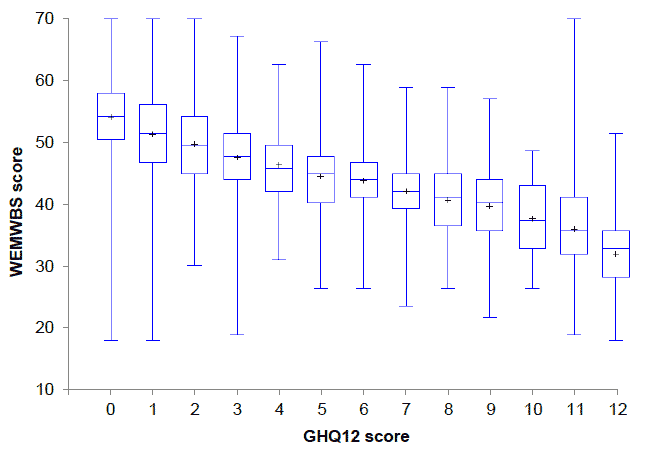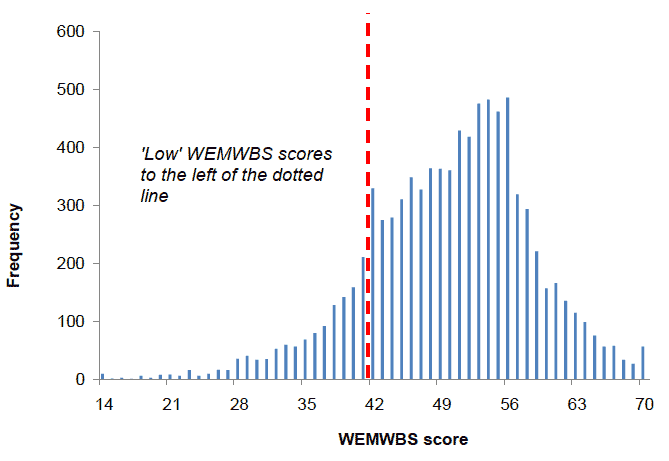Scottish Health Survey - topic report: mental health and wellbeing
The Scottish Health Survey (SHeS) provides information on the health and factors relating to the health of people living in Scotland that cannot be obtained from other sources. This topic report is secondary analysis of the 2012 and 2013 surveys, exploring factors associated with the mental health and wellbeing of adults aged 16 years and older.
This document is part of a collection
3. WEMWBS and GHQ12
In this section, trends on both mental wellbeing measures are examined for the years in which they were included in the Scottish Health Survey. Results are described in more detail for factors identified in the literature review.
3.1 Trends in WEMWBS mean scores since 2008
WEMWBS has been included in the Scottish Health Survey since 2008. The mean score in 2013 was 50.0, a slight rise since 2012 (49.9) but a figure that has not significantly changed since 2008. In line with results from previous years, the average WEMWBS score for men was higher than for women (50.3 and 49.7 respectively). The difference in mean scores by gender was not significant.
Mean WEMWBS scores by age group have also changed little since 2008, and the pattern of mean scores across the age bands each year has remained similar throughout the period. The mean score is relatively high in lower age groups, gradually reduces to a low among the 45-54 age group, rises to a peak between ages 65-74 before falling among adults aged 75 and over. This pattern of mean WEMWBS score by age closely matches the life satisfaction scale by age group in an analysis of the British Household Panel Study[1].
3.2 Trends in GHQ12 score since 2003
The proportion of adults aged 16 or over with a GHQ12 score of four or higher, indicating the presence of a possible psychiatric disorder, has shown no significant change since 2003, remaining steady at around 15%. An unvarying proportion by gender was also observed over these years, with prevalence remaining at around 13% for men and 17% for women.
In all surveys since 2003, adults in the 65-74 year age band have consistently shown the lowest proportion scoring 4 or more on GHQ12, at around 11%. The highest proportion generally varies each year across the three age bands covering ages 35-64. In later years of the survey, the proportion of men scoring four or higher fluctuates by age band much more than the proportion by age among women. For example, in 2012 the proportion of men scoring four or higher varied from 7% (among 16-24 year olds) to 21% (25-34 year olds). Among women the range was 14-19%.
3.3 Relationship between WEMWBS and GHQ12
The boxplot in Figure 3A illustrates a lower WEMWBS score is associated with a higher GHQ12 score. That there is a wide range of WEMWBS scores among respondents with the same GHQ12 score suggests the two scales are not measuring the same thing.
In Figure 3A, each of the twelve vertical boxplot diagrams show (from lowest to highest on the vertical WEMWBS axis):
- the lowest WEMWBS score for anyone in that group (i.e. with the corresponding GHQ12 score shown)
- the lower quartile: the WEMWBS score below which are 25% of adults in each group (i.e. with the corresponding GHQ12 score shown)
- the median: the WEMWBS score below which are 50% of adults in each group (i.e. with the corresponding GHQ12 score shown)
- the upper quartile: the WEMWBS score below which are 75% of adults in each group (i.e. with the corresponding GHQ12 score shown)
- the highest WEMWBS score for anyone in that group (i.e. with the corresponding GHQ12 score shown)
The aggregate scores for GHQ12 and WEMWBS show a moderate negative correlation (Pearson r=0.51). The median WEMWBS score declines as GHQ12 score increases, most rapidly nearest the two extremes on the GHQ12 scale. The 'middle 50%' (i.e. between the lower and upper quartiles) with each GHQ12 score follow a similar pattern. However, there remains a relatively wide range of WEMWBS scores across most GHQ12 scores, including some clear outliers reporting the maximum or minimum possible WEMWBS score.
Relationship between WEMWBS and GHQ12 scores, 2012/2013

Each of the 14 component questions in the WEMWBS scale are scored on a five point Likert scale ranging from 1 ('none of the time') to 5 ('all of the time'). As each of the items relate to positive facets (feeling optimistic, confident, etc.), higher scores are indicative of positive mental wellbeing. All of these items, and the aggregate WEMWBS score, show statistically significant higher mean scores among those who do not display signs of a possible psychiatric disorder (GHQ12 < 4) compared to those who do (GHQ12 >= 4). Mean differences between each group vary by item, with the biggest difference observed in items 'Been feeling good about myself' and 'Been feeling confident'. See Table 3A, below.
The difference in the aggregate WEMWBS mean score by GHQ12 mental health status, also presented in Table 3A, is considerable. Adults with a GHQ12 score of less than four have a mean WEMWBS score of 51.8, nearly 12 points higher than those who display signs of a possible psychiatric disorder (40.0).
WEMWBS component question mean scores, by GHQ12 mental health status, 2012/2013
| GHQ12 Less than four |
GHQ12 Four or more |
Difference | |
|---|---|---|---|
| Been feeling optimistic | 3.4 | 2.8 | 0.6 |
| Been feeling useful | 3.6 | 2.8 | 0.8 |
| Been feeling relaxed | 3.5 | 2.6 | 0.9 |
| Been feeling interested in others | 3.7 | 3.1 | 0.6 |
| I've had energy to spare | 3.1 | 2.3 | 0.9 |
| Been dealing with problems well | 3.7 | 2.8 | 0.9 |
| Been thinking clearly | 4.0 | 3.1 | 0.9 |
| Been feeling good about myself | 3.7 | 2.6 | 1.1 |
| Been feeling close to others | 3.7 | 3.0 | 0.7 |
| Been feeling confident | 3.7 | 2.6 | 1.1 |
| Been able to make up own mind | 4.1 | 3.3 | 0.8 |
| Been feeling loved | 4.1 | 3.4 | 0.7 |
| Been interested in new things | 3.6 | 2.8 | 0.8 |
| Been feeling cheerful | 3.8 | 2.8 | 1.0 |
| WEMWBS score | 51.8 | 40.0 | 11.8 |
Overall results for mental health and wellbeing measures
The mean aggregate score for WEMWBS over the combined 2012 and 2013 period was 49.9. The distribution of the scores is shown in Figure 3B. This shows the cut-off point (scores of 41 and below) used in all analyses discussed in this report indicating a low WEMWBS score.
Distribution of WEMWBS scores, 2012/2013

The distribution of scores on the GHQ12 is highly skewed. More than 60% of respondents score zero. In 2012/2013, 15% of respondents aged 16 or over scored four or higher on GHQ12, indicating the presence of a possible psychiatric disorder.
Contact
Email: Craig Kellock
There is a problem
Thanks for your feedback